

项目选址位于张家界一个陡峭山坡上,山脊盘旋而上,竖向落差很大。张家界地貌综合了丹霞地貌、石英砂岩地貌的特征却又不尽相同,形成了独具一格的的峰林地貌。场地和道路之间隔着陡峭的山坡,山坡上是密集的翠绿树林,野趣横生。
The project’s site is located on a steep hillside in Zhangjiajie, with the ridges circling upward and the vertical drop is very large. The Zhangjiajie landform combines the characteristics of Danxia landform and quartz sandstone landform, they are not identical, which results in the formation of a unique peak forest landform. There are steep hillsides stand between the site and the road. Moreover, the dense verdant woods on the hillside adds more fun to the grand view.
▼露台,alcony view
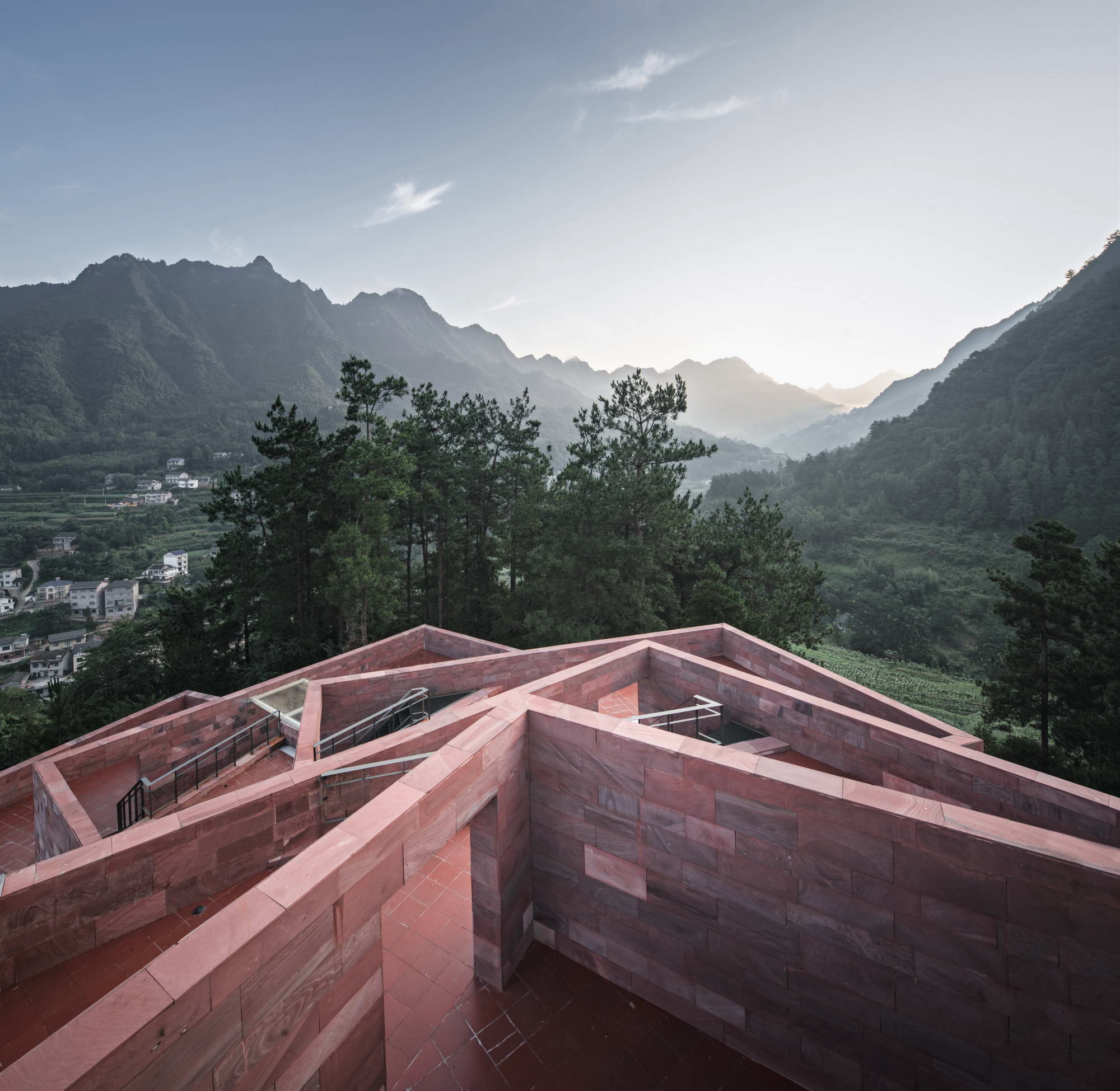
▼模型照片, Model photos
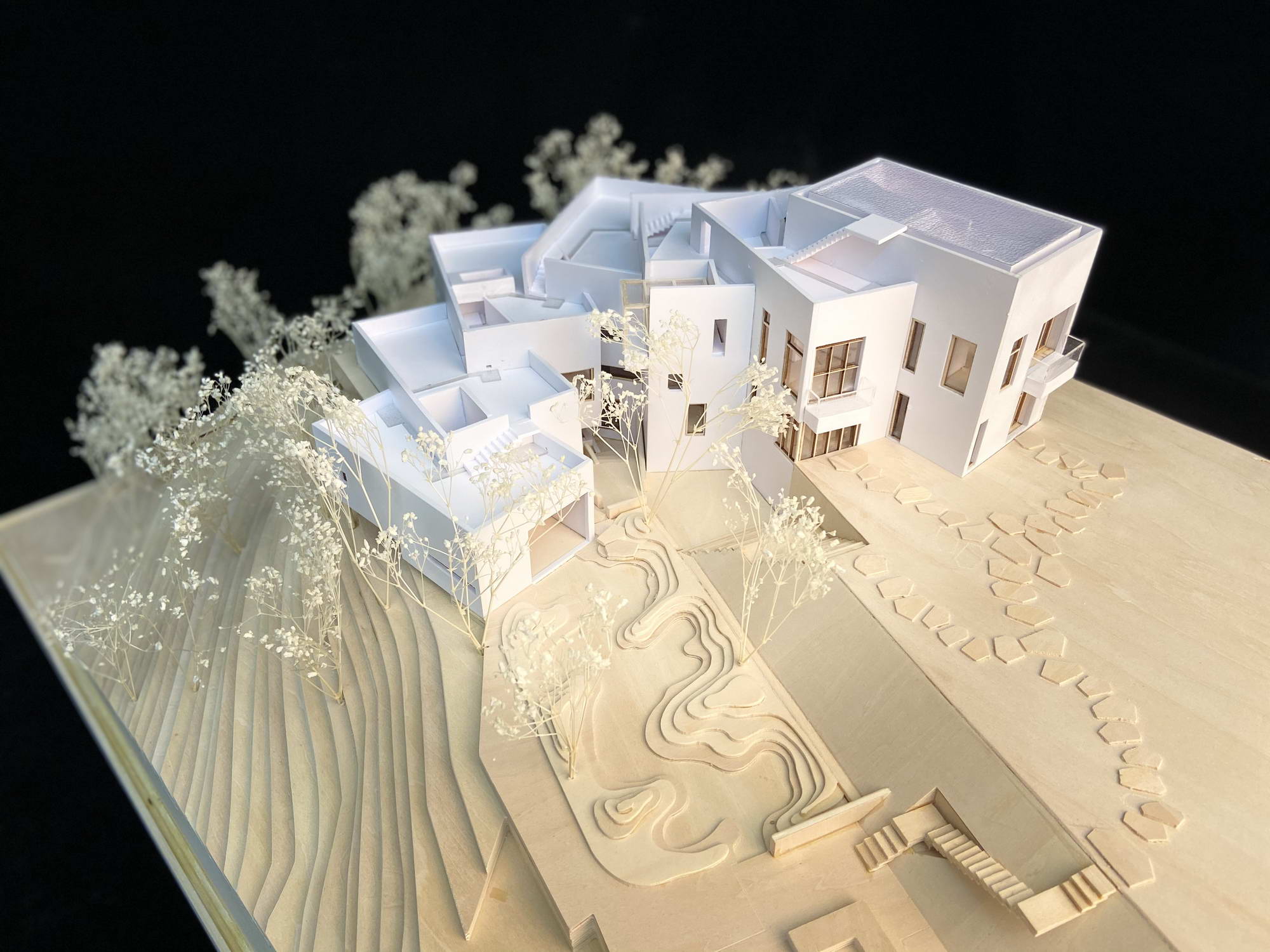
▼总平面图,masterplan
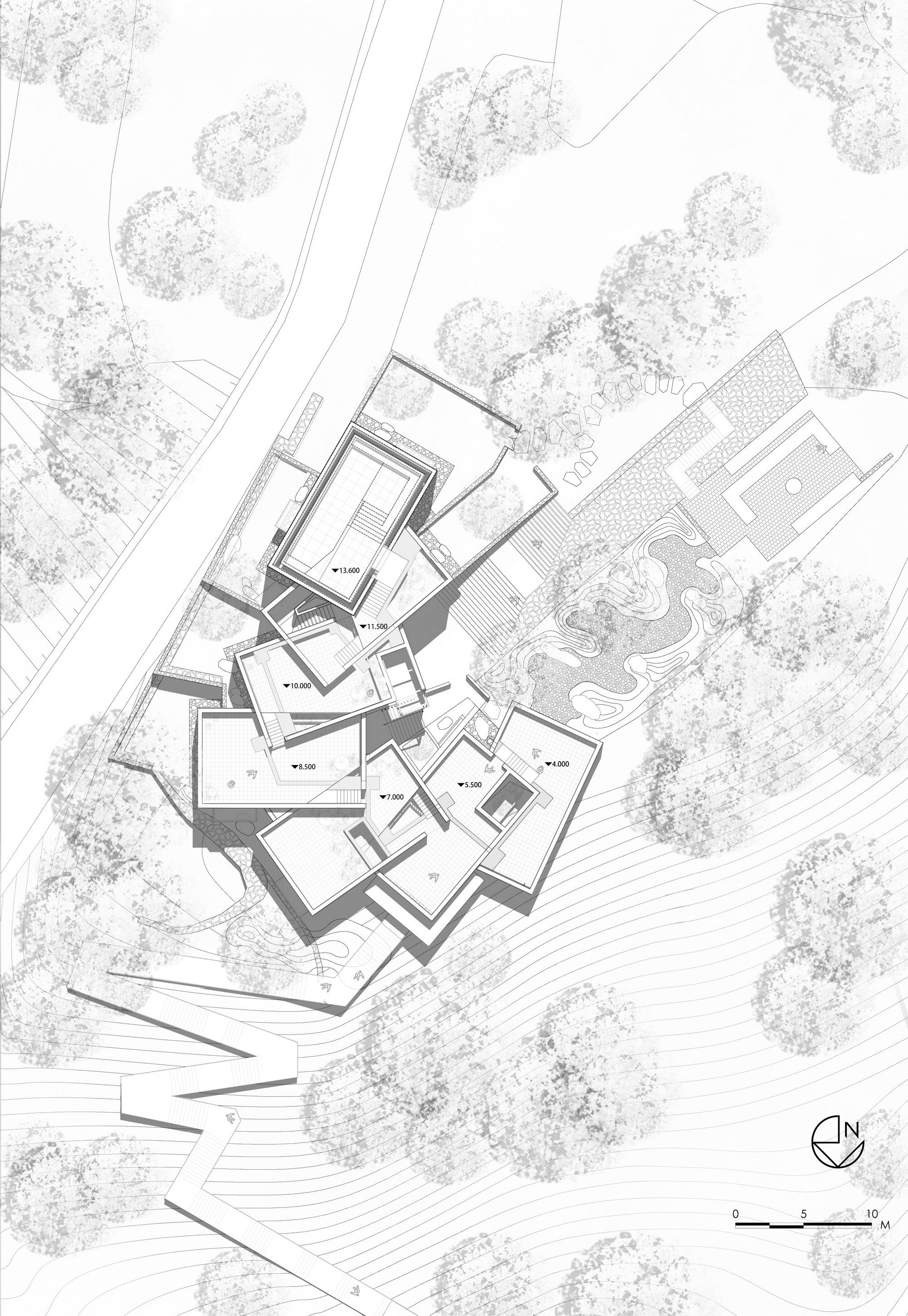
设计切入点是对于场地的思考,地势落差很大,与其为了规避严苛的地形条件而将场地粗暴平整,不如让建筑自由的沉浸在周遭的一切里,利用地势的落差去布置建筑,使得建筑与场地以一种共生的姿态自然生长。
The entry point of the design is taking the site into consideration due to the enormous terrain difference. Rather than making the site rough and flat to avoid the harsh terrain conditions, it is better to let the building be immersed in everything around it freely, and use the terrain difference to lay out the building , then make the building blends in the site as if they naturally grow together.
序曲:相地择材
Overture: Choose materials locally
几轮现场踏勘期间里偶然路过一条河流,河流里的红色石块由雨后山上滚落坠入,也将周边河水晕染成微红,松树林高耸挺拔,林木之间层叠的碧绿是场地最原始的印象,红绿相映构成了张家界朴素蓬勃的地貌色彩。借几片红色砂岩去构筑一座山谷间的红色房子,形成了设计的初心。
During several rounds of site surveys, I accidentally came across a river. The red rocks in the river rolled down from the mountain after raining, and the surrounding river was thereby tinted reddish. The green wave of the pine forest was the original impression to me. Hence the red and green together form the simple and vigorous landscape of Zhangjiajie. Borrow a few pieces of red sandstone to build a fire like house in the valley, forming the original heart of the design.
▼马克·罗斯科,《无题(红与红)》,Mark Rothko,UNTITLED (RED ON RED)

独白:透明感知
Monologue: Transparent perception
《反对阐述》一书中,苏珊·桑塔格指出:“透明是艺术——也是批评中最高、最具解放性的价值。透明意指体验事物自身的那种明细、或体验事物之本来面目的那种明晰。”
In the book against interpretation and other essays, Susan Sontag pointed out: "Transparency is art-and the highest and most liberating value in criticism. Transparency means the kind of detail of experiencing things themselves, or the essence of experiencing things. That kind of clarity."
为了保持建筑肌理与自然画布最原始的对话,导向人与建筑最诚实的感知状态,设计中克制了过多对于形的创造和空间韵律的人为阐述,引导人与建筑的多维度对话,注重空间的氛围营造,以恰到好处的沉默,隐身于“不在场”的辗转、体验和共情中。
In order to maintain the original communication between the architectural texture and the natural canvas, and also to guide the most authentic state of perception between people and architecture, the design has restrained itself to over express the artificial interpretations of the form creation and the rhythm of space, guiding the multi-dimensional communication between people and architecture, focusing on creation of the atmosphere which caused by the space. With the exact amount of silence, it gains the ability to hide itself among the lingering, experience and empathy of “absence”
▼建筑东侧航拍,architecture Overview

间奏 :五感觉醒
Interlude: Waking up through your five senses
钱钟书先生曾讲到“颜色似乎会有温度,声音似乎会有形象,冷暖似乎会有重量,气味似乎会有锋芒,“红杏”爱“闹”,“燕语”如“剪”,“莺歌”似圆。”
Mr. Qian Zhongshu once said, "Color seems to have temperature, sound seems to have an image, warmth and coldness seem to have weight, smell seems to have sharp edges, " Red Apricot " loves "lively", " swallow's voice " like " scissors ", " warbler's voice " seems round."
▼建筑西侧草坪视角,building facade

设计中利用场所的秩序关系,将入口放置于山脚的树林,林中步道拾阶而上,路径序列在叙事中展开,参与者似乎经历了某种洗礼仪式,从单一的感知中释放出来,丰富了体验纬度,倾听着这座红色房子的低声吟唱,安抚了来自尘世间,风尘仆仆的心境。
In the design, I use the order relationship to place the entrance in the woods at the foot of the mountain. With the trails stepped up, the path sequence unfolds in the narrative. The participants seem to have experienced a certain baptism ritual, released from a single perception, enriched the experience latitude. While listening to the whispering chant of this red house, it appeased the mood from the earthly world.
▼建筑入口花园,architecture Overview

宣叙:边界之间
Narrate: Between boundaries
建筑空间的线性叙事由入口开始,内部空间的序列逻辑是外部自然空间的延续和演变,虚化空间的边界概念,建筑形成一种暧昧的空间情绪。将功能所需原本的大体量拆解为七个建筑单元,每个单元都被作为独立的句法对待,实现着各自的功能预设。依着地势盘旋层叠向上,扭转、旋转的空间手法打碎了整体建筑的厚重感,同时模拟了山脉绵延的形态特征。找到句法之间以及与场所之间的稳定状态——相互纠缠又相互独立。
The linear narrative of the architectural space begins with the entrance. The sequence logic of the internal space is the continuation and evolution of the external natural space. The boundary concept of the virtual space is blurred, and the architecture forms an ambiguous spatial emotion. The original mass required for the function is disassembled into seven building units, and each unit is treated as an independent syntax to realize its own function preset. According to the topography of the terrain, the space technique of twisting and turning upwards, twisting and rotating shattered the heavy sense of the overall building, simulating the morphological features of the rolling mountains at the same time. Find a stable state between the syntax and the place-intertwined and independent.
▼建筑门厅入口,building entrance

建筑内部路径的组织上试图模糊“楼层”的概念,台阶以一种不经意的姿态,散布在空间的内部建筑动线中,消减楼层的高差。空间路径如丝带般不断延伸,曲径通幽,移步换景,纵向联系上更加自由流畅。使得参与者“游山”的体验不被打断而一直延续。
The organization of the internal path of the building attempts to obscure the concept of "floor". The steps scatter in an inadvertent posture in the internal architecture of the space to reduce the vertical difference of the floor. The spatial path continues to extend like a ribbon, the winding path leads to the quiet, the steps change within the vertical connection is freer and smoother. As a result, the participants' experience of "touring the mountains" will come along without any interruption.
▼概念分析,Concept analysis

旁白:建造逻辑
Narrator: Building logic
最初的设计中考虑布置大规格的岩片,由于现场位于陡峭山坡,使得建筑材料的制作,运输,建造都极为不便,无法运用大型吊装机械,于是将大块的砂岩石片再切小,分割成6类不同尺寸,方便工人独立操作。考虑建筑形态与结构的统一性,平衡建造成本的同时以一种清晰力学逻辑将6类不同尺寸的砂岩石片排列组合,使之在自然的雕塑中呈现粗野的戏剧张力。
In the initial design, large sized rock pieces were considered for layout. However, the site is located on a steep hillside, it is extremely inconvenient to manufacture, transport, and build building materials. Large lifting machinery cannot be used, so the large sandstone pieces are cut again and divided into 6 different sizes, which will be more convenient for workers to operate independently. Considering the unity of architectural form and structure, while balancing the construction cost, the six types of sandstone pieces of different sizes are arranged and combined with a clear mechanical logic. Therefore, it shows the rough dramatic tension in the natural sculpture.
▼西侧后花园,building exterior view
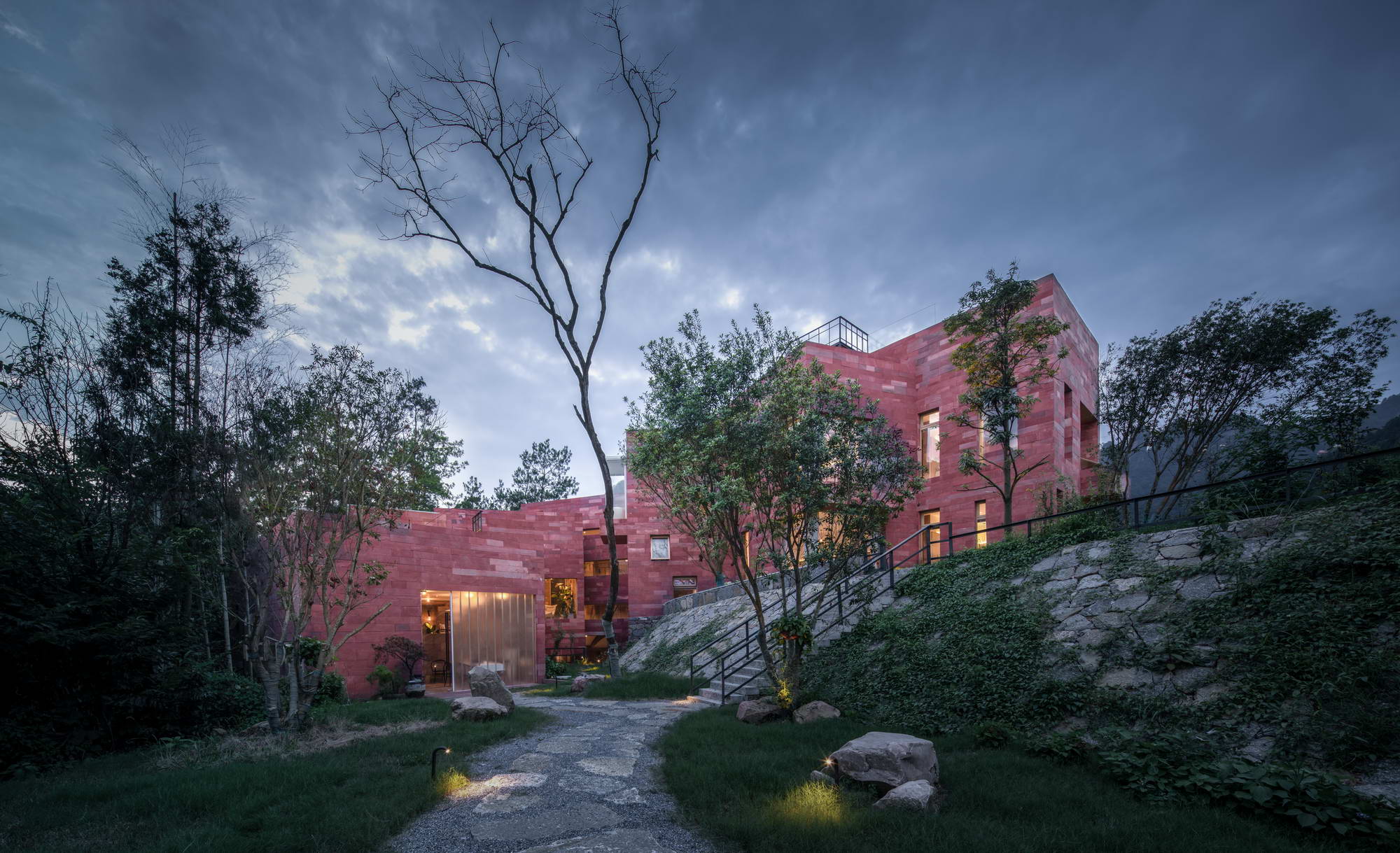
▼西侧后花园,building exterior view

建筑内外由叙事性的路径连通,直抵建筑一层。作为重要的公共空间承担着接待,沟通,交流等重要功能,将餐厅厨房等辅助空间置于负半层,同时利用体块的扭转形成的天然夹角构筑观景平台。
The inside and outside of the building are connected by a narrative path to the first floor of the building. As an important public space, it undertakes important functions such as reception, interaction and communication. The auxiliary spaces such as the restaurant and kitchen are placed on the negative half-level. At the same time, the natural angle formed by the torsion of the body is used to construct the viewing platform.
▼入口门厅,interior space
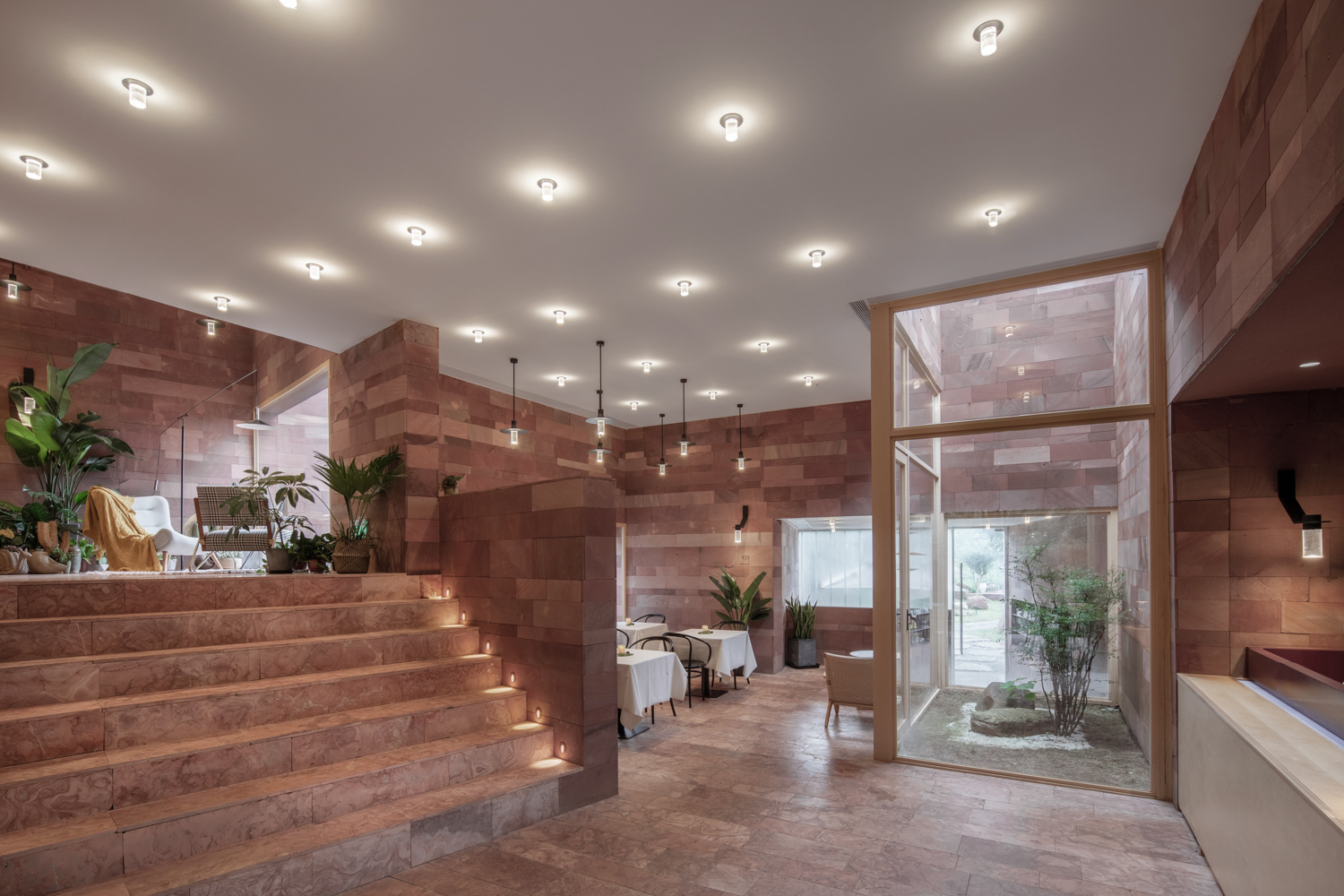
五个建筑单体作为主要的客房区域,呈现不同的空间状态,通透的落地窗形成景框,渗透别具一格的自然景观。承载独特的居住体验。螺旋通高楼梯作为轴承,将其中三个居住单元形成组团。通过纵向的路径序列串联起另外两个居住单元。整个居住空间形成一个多层次的有机整体,在空间流动上互为因果。
The inside and outside of the building are connected by a narrative path to the first floor of the building. As an important public space, it undertakes important functions such as reception, interaction and communication. The auxiliary spaces such as the restaurant and kitchen are placed on the negative half-level. At the same time, thenatural angle formed by the torsion of the body is used to construct the viewing platform. The five architectural units serve as the main guest room areas, presenting different spatial conditions. The transparent floor-to-ceiling windows form a frame that penetrates the unique natural landscape, converging into a unique living experience. The spiral staircase serves as a bearing, forming three of the living units into groups. Two other living units are connected in series by a longitudinal path sequence. The entire living space contains a multi-level organic whole, which is causal to each other in the flow of space.
▼入口门厅,interior space

▼旋转楼梯,spiral staircase
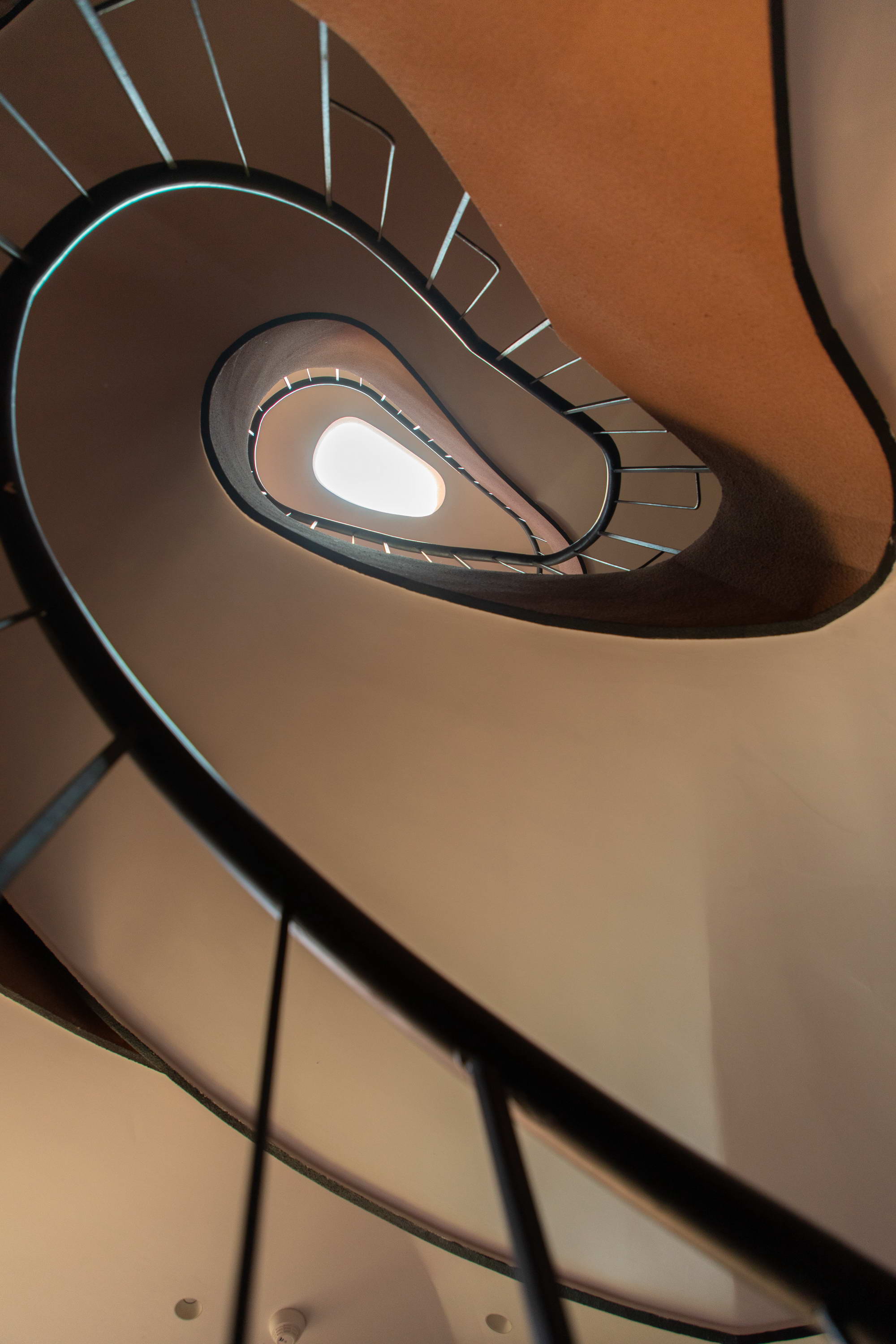
▼房间窗景,interior space

▼房间窗景,interior space

▼休息区,interior space

▼浴室,interior space

▼茶室,interior space

▼休息区,interior space

▼休息区,interior space

▼书桌,interior space

▼旋转楼梯,interior space

▼走廊,interior space

咏叹:高山流水
Aria: Lofty mountains and flowing water
传统的观念中雨水是财亦是福,四方之财如同天上之水,水聚天心,既是藏蓄之所,也是财禄象征。是一种美好心念的寄托,也是一种神性的隐喻。
In the traditional concept, rainwater is wealth and blessing. The wealth of the four sides is like the water of the sky. The water gathers in the heart of the sky, which is both a storehouse and a symbol of wealth. It is a sustenance of a good heart and a metaphor of divinity.
设计中希望雨水与建筑不是简单直接的介入方式,而是希望产生对“精神场所”的探索,将各层雨水引入水槽,让水流层层跌落,从象征的角度来讲,雨水作为神性的隐喻符号,神的时间没有过去和将来,只有现在。让雨水作为丰富整个空间的体验的重要组成,尊重此时此刻的感知状态,剥离既定的表象特征,以栖息的诗意渲染整座建筑,最终在底层庭院中画上休止。
In the design, it is hoped that rainwater and architecture are not interact in a simple and direct way, Instead, it is expected to produce an exploration of the "spiritual place", introducing rainwater into each tank, and letting the stream fall from layer to layer. From a symbolic point of view, rainwater is divine metaphorical symbol, God's time has no past and future, only the present. Let the rainwater be an important component of enriching the experience of the entire space, respect the state of perception at this moment, strip away the established representational features, render the entire building in a poetic manner, and finally draw an end on the ground floor courtyard.
▼建筑航拍,building exterior view

雨水以温润的方式流淌过重叠的“建筑之山”,是形与物的缠绵,也是表象与体验的纠葛。设计师在整个设计中,以极致的克制,将人为阐述的存在感降为最低,使得建筑的意义就在体验本身,体验则更是空间的构成。
Rainwater flows through the overlapping "mountain of architecture" in a gentle way, which is the entanglement of reality and metaphysic, therefore also the entanglement of appearance and experience. Throughout the entire design, the designer makes a huge effort in restraining and minimizing the existence of artificial interpretation. Hence making the meaning of the building is experience itself, and the experience is the composition of the space.
▼水聚天心分析图,Diagram

尾声:体验何为
Ending: What is the experience
建构和谐的建筑与自然,建筑与人的关系是设计师追求的永恒主题,在本次设计中我们试图在探讨一种“透明体验”的可能性,建筑从自然中生长,建筑与人的关系从对空间的感知和体验中搭建,共同谱写山谷间的红色交响。
To orchestrate a harmonious melody of building and nature, the relationship between building and people is the eternal theme pursued by the designer. In this design, we try to explore the possibility of a "transparent experience", the building purely appears out of nature. The relationship between building and people is formed from the perception and experience of space, and they jointly compose the red symphony between the valleys.
▼远眺建筑,Overlooking the building

▼模型照片, Model photos






▼总平面图,plane analysis chart
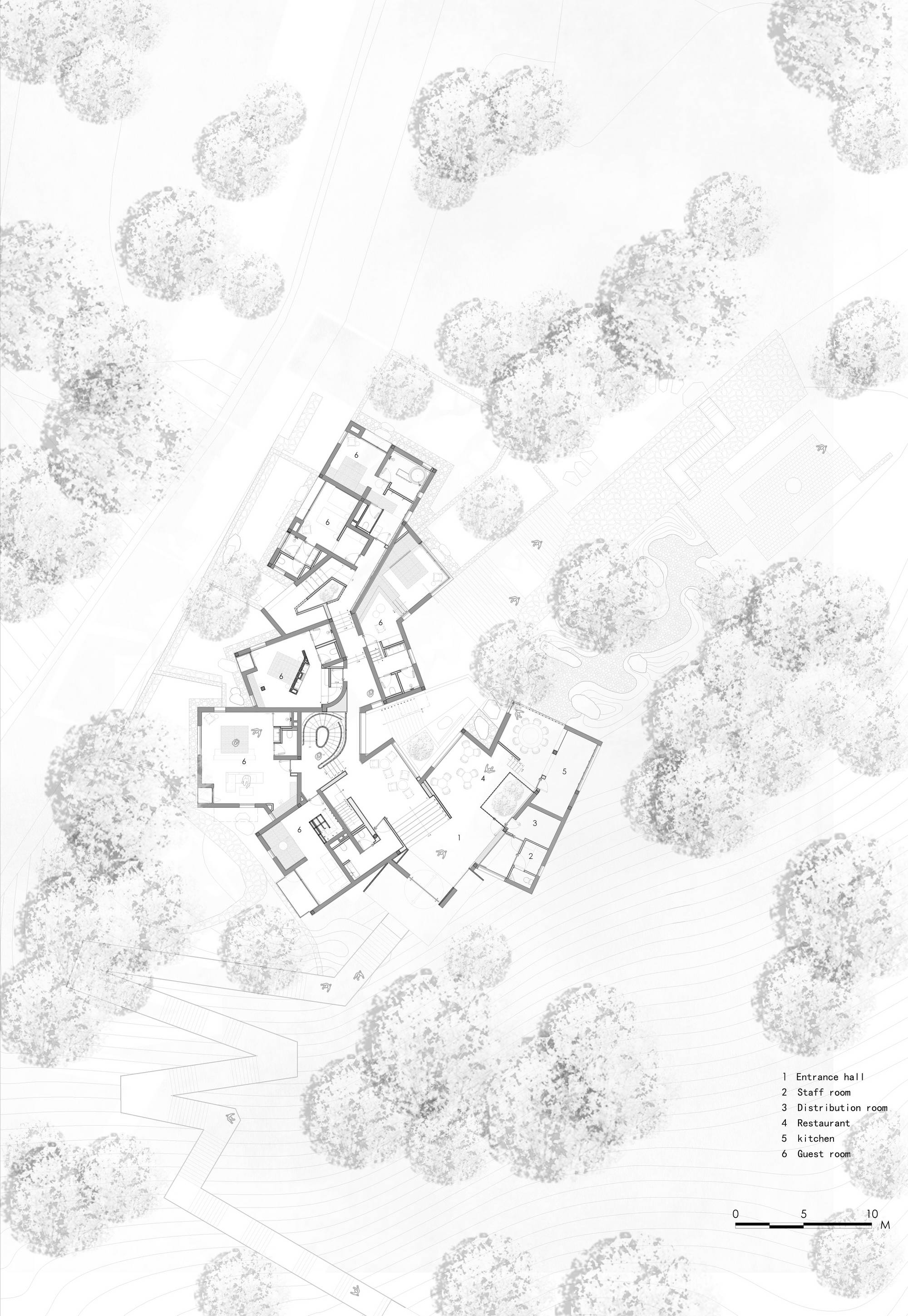
▼东立面图,east elevation

▼西立面图,west elevation

▼南立面图,south elevation

▼北立面图,north elevation

▼剖面图1 section 1

▼剖面图2 section 2

▼剖面图3 section 3

▼节点,detail

设计方(建筑&室内&景观):素建筑设计事务所 SUA
Design: SU Architects(Architects,Interior,Landscape)
地理位置:湖南,中国
Location: Hunan, China
主持&主创建筑师:郭少珣
Architect in Charge: Shaoxun Guo
设计团队:姚熠琳,张志坤,刘悦,梁鑫,赵泽玮,徐桦,石崇鹏,韩雨恩,李梦,许文洁,林仙桂
Architects: Yilin Yao,Zhikun Zhang,Yue Liu , Xin Liang ,Zewei Zhao,Hua Xu,Chongpeng SHi,Yuen Han, Meng Li,Wenjie Xu,Xiangui Lin